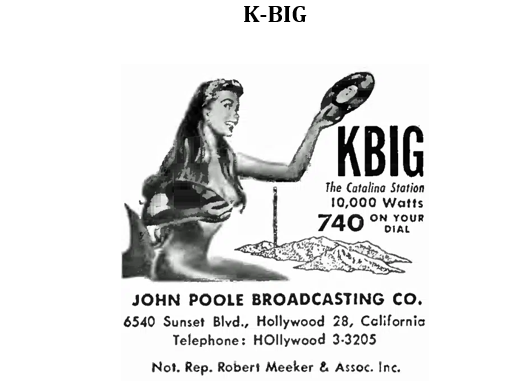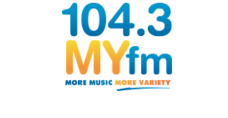Special thanks to Ray Robinson and Jeff White for sharing this nostalgic story on K-BIG
Jeff: Today Ray Robinson brings us some interesting historical notes regarding the offshore beginnings and nautical connections of one of Southern California’s best-known stations – KBIG, or ‘K-BIG’. As an AM station in the early 1950s, it created a distinctive presence by broadcasting from a popular passenger ferry, the S.S. Catalina, while plying the waves of the Pacific to and from the island of the same name. Here’s Ray to tell us more.
Ray: Thanks, Jeff. I’ve lived in the Los Angeles area for 40 years now, and throughout that time, K-BIG has been a fixture on the FM dial at 104.3 MHz. The station has been through many ownership and format changes during its lifetime, but what many people don’t realize is that it started out not on the FM band, but as an AM station, and not actually on the California mainland at all. So, let’s go back to the beginning, and I have to thank Dr. Martin van der Ven in Germany, an occasional contributor to this program, for some of this material today.
K-BIG was founded by John H. Poole in 1952 and began broadcasting in the June of that year from Catalina Island some 23 miles off the coast of California, and 26 miles from the Port of Los Angeles, to its north. The island itself is 22 miles long and 8 miles wide, covering an area of some 75 square miles. It’s administered as part of Los Angeles County, and the principal town on the island is Avalon.
Known as "The Catalina Station", Poole knew K-BIG would have wide coverage of Southern California by broadcasting the station's directional 10,000-watt signal across ocean water. And indeed, K-BIG was heard from Santa Barbara in the north to south of the Mexico border, a 200-mile stretch of the California coastline, including a large audience in Los Angeles. In 1958, the station adopted the theme tune ‘Twenty Six Miles (Across the Sea)’ by The Four Preps.
The station became popular as it presented an island theme and scheduled music, news, and commercials differently than its competitors. Poole claimed people knew that if they changed stations during a commercial, they would always find something interesting on K-BIG, which mostly played a mix of popular music genres, including Big Band, Jazz and contemporary hits. But they also provided news updates and a few talk shows, including the notable “Catalina Conversations,” which featured interviews with local celebrities, island residents, and visitors.
The station was a daytimer to protect KCBS 740 in San Francisco, and operated only from local dawn to dusk. The K-B-I-G call letters were selected in honor of the station's Chief Announcer, Carl "Mr. Big" Bailey, who hosted the station’s morning shows from sign-on until noon in its early days. He got the moniker “Mr. Big” due to his 6’10” frame which was truly exceptional in the 1950’s.
The station’s studios and transmitter were located on Catalina Island, while the business office was situated at 6540 Sunset Boulevard in Hollywood, where Poole also built additional studios for production and auxiliary purposes.
Carl Bailey – ‘Mr. Big’ – was a prominent figure in the radio industry, and he wanted more than anything to help John Poole create a station that would stand out in the crowded Southern California market. And so, in the mid-and late-1950s, he often broadcast live on weekends from a passenger ferry, the S.S. Catalina, which had been carrying as many as 3,800 passengers a day on the 2½ hour voyage between the Port of Los Angeles and Avalon since 1924.
Many K-BIG listeners traveled alongside regular passengers on the journey to Avalon, and Carl would interview some of them during the voyage and when disembarking from the ship. The passengers knew that their families were often eagerly waiting to hear if they had completed the voyage safely. Through K-BIG AM 740, they were sometimes able to hear their loved ones’ voices. The station also hosted occasional live performances by various artists aboard the S.S. Catalina, creating a unique and intimate concert experience that was broadcast to listeners. The offshore broadcasts were a strategic move to capture the listeners’ imagination and leverage the established reputation and iconic status of the ferry.
Of course, the station didn’t actually transmit from the S.S. Catalina (other than their studio-to-transmitter link), but merely used it as the base for some very unusual, and I dare say romantic, live outside broadcasts.
In November 1957, while aboard the sea-going S.S. Catalina, Carl Bailey got in touch with the pilot of a plane circling above. The aircraft, from the Los Alamitos Naval Air Station, was ‘tracking’ the ship for radar spotting practice, and the DJ described it to listeners of his regular sea-going program. Coincidentally, the airmen were using K-BIG as a navigational fix, and when Carl called to the plane to dip a wing if they were tuned in, the pilot complied! When he returned to Los Alamitos, the pilot wrote a letter thanking the disc jockey for the Navy plug and invited Carl to visit the Naval Air Station. This he subsequently did and provided listeners with a full report of the conducted tour he received.
A year later, in November 1958, K-BIG launched a new promotion to draw attention to its 740 kHz position on the dial. The 740th passenger boarding the S.S. Catalina each day at Los Angeles harbor for the cruise to Avalon was awarded prizes, including lunch, dancing, and sightseeing for two, to make the island visit more enjoyable. Carl Bailey interviewed the lucky winners each day by ship-to-shore radiophone from Avalon on weekdays, and in person on his ‘Catalina Cruise’ broadcast from the ship on Saturdays and Sundays.
A memorial on Wrigley Plaza along the waterfront in Avalon on Catalina Island honors Carl “Mr. Big” Bailey (who passed away in 1984), saying he’s considered to be “the first sea-going disk jockey in the world”.
On February 15, 1959, Poole launched KBIQ at 104.3 on the FM band in Los Angeles, simulcasting its AM sister station K-BIG. In 1963, the call was changed to KBIG-FM, and the station added a staff of "K-BIG Singers", who would sing the station's jingles and also record station albums to offer to listeners.
Later in the 1960’s, to improve efficiency, the island location was reduced to just a transmitter facility, with the chief engineer residing on-site, while K-BIG’s AM programming originated from Hollywood and was sent to the Catalina transmitter via a microwave link.
In 1968, KBIG-AM and FM were bought by Bonneville International for $2 million. The new owners continued with a ‘beautiful music / easy listening’ format playing mainly instrumentals. It sounded like this on October 13th, 1979:
The following year, in 1980, Bonneville sold the AM station on 740 kHz to Crawford Broadcasting, which has operated a daytime-only Christian talk format on that frequency ever since as KBRT, or ‘K-BRITE’, with the 10 kW transmitter remaining on Catalina Island to this day.
By the early 1990’s the FM station was playing ‘today’s hits and yesterday’s favorites’:
Today, the FM station is owned by iHeartMedia and transmits with 65,000 watts. It plays contemporary adult hits from the 90’s to now, branded as ‘104.3 MYfm’, and identifies simply as KBIG, having dropped the –FM suffix in 2013.



